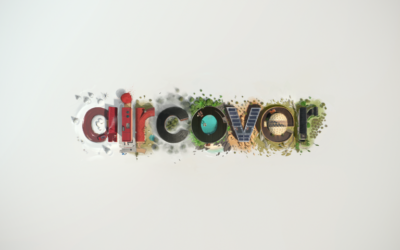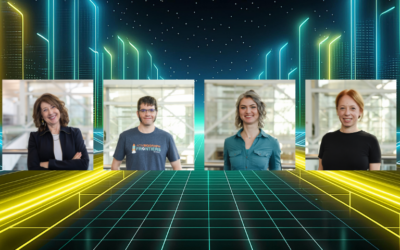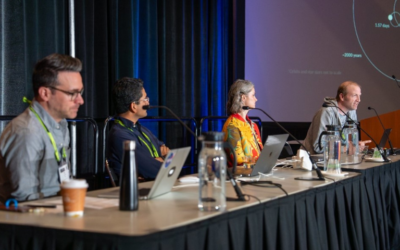Image Credit: © Sketchsoft Inc. Artist Sangyun Kim drawing an airplane with Feather.
“Drawing is one of the oldest forms of human expression and communication. We believe that 3D drawing will take these to the next level,” Yongkwan Kim, founder and CEO of Sketchsoft and SIGGRAPH 2023 contributor, says. At SIGGRAPH 2023, prepare to see the next level of 3D drawing with “Feather: 3D Sketchbook” during Kim’s Appy Hour presentation. Read on for a look behind the app.
SIGGRAPH: What inspired the research and development of “Feather: 3D Sketchbook Light as a Feather“? Were there any specific gaps in existing drawing apps that led to the development of this app?
Yongkwan Kim (YK): Traditional pen and paper have always been a source of inspiration for making “Feather.” We think that 2D digital drawing apps have done a great job adapting those familiar concepts, as we are still moving our fingers to place digital paper and using a pen to paint on a tablet. However, the situation with 3D creation apps was quite different. Unlike the 2D creative process, where you can start with rough sketch lines and gradually build them up, 3D apps often require you to begin with surfaces and volumes, skipping the lines. We felt that these overly specific geometries limit the users’ speed and freedom to express ideas early on. So, we decided to build an interface that allows everyone to start by drawing lines on a “blank slate,” even in 3D space.
SIGGRAPH: Tell us how you developed this work. What problems does it solve?
YK: We combined a 2D drawing interface with a 3D navigation technique to streamline complex 3D creation tasks. Our system enables users to create 3D lines by drawing an initial 2D line that generates an extruded surface and subsequently projects additional lines onto that surface from different viewpoints. Users can also translate, rotate, and scale 3D lines as shown on a screen without worrying about their positioning in 3D space with the help of an axis of transformation fixed to the center of the screen and viewing direction. Once users get familiar with viewing the 3D space, they can perform 3D creation by simply repeating 2D drawing inputs in all cases: drawing, erasing, selecting, and transforming. In addition, we built our system with web-based 3D graphics that run on top of a web browser. Users can continue working with 3D drawings across mobile, tablet, and desktop devices and use them for subsequent 3D modeling and rendering processes.
SIGGRAPH: What challenges did you face in its development? What surprised you most during the process?
YK: The most significant challenge was discovering and overcoming the gap between existing 3D creation techniques and the drawing experience people expected. For example, we found that people often wanted to fix the front-to-back relationships among 3D lines shown on the screen by ordering the “layers” as they would do with conventional 2D drawing apps. However, the front-to-back relationships among 3D lines are geometrically determined only by their respective 3D coordinates and the viewpoint. This forced us to design the interface with the concept of groups instead of layers to avoid confusion. Overall, we created the input interface as similar to 2D drawing as possible while reinforcing user awareness of 3D space in viewing the results. In particular, our system receives 2D user input as-is but always leads users to shift viewpoints between each step of creating or moving 3D lines. What was surprising was how quickly people adapted to this approach of treating 3D objects as if the objects were 2D, even if they were viewing them in 3D space.
SIGGRAPH: How do you envision the feedback from Appy Hour participants will be implemented in the future of the app?
YK: As toolmakers, meeting with current or future users is crucial for us to test and refine the tool. We are thrilled to participate for the first time at SIGGRAPH, which brings researchers, engineers, and artists together to share technology’s birth, evolution, and application. We’d love to hear from the audience in industry and academia to make “Feather” more applicable in practice. We welcome all feedback, including comments on the app’s current state, new technologies we could apply, and features essential to specific processes that will make our app work with other tools instead of being isolated.
SIGGRAPH: What potential applications or creative possibilities do you foresee with the integration of 3D drawing capabilities available to the general public on a tablet?
YK: Drawing is one of the oldest forms of human expression and communication. We believe that 3D drawing will take these to the next level. Imagine being able to modify shots of an animation storyboard in a meeting, to teach anatomy by drawing bones and muscles, to 3D capture your new office and plan the interior of it, or to paint some flowers and place them by the window of the virtual space where your avatar lives — all with the 3D drawing. Unlike desktop software for industrial purposes, cross-device tools on the cloud, like Feather, can be fused with various situations and creative processes. A tablet with a highly portable form factor, input capability to draw on, and sensors to gather 3D information of surroundings will be one of the most versatile options for 3D drawing. We expect the whole pipeline for 3D creation will gradually become available in the hands of the general public, just as making music and videos became.
SIGGRAPH: Looking ahead, do you have any plans for further improvements or expansions to “Feather: 3D Sketchbook Light as a Feather”? Are there any new features or enhancements you would like to explore?
YK: “Feather” is a “living product” that users and developers are shaping together. In the long run, we want to make it not only just a tool but a community for sharing and interacting with the drawings. We also consider adding more powerful 3D drawing and industry-specific features for enthusiasts and professionals. Those will include other ways of creating sketching surfaces like loft and sweep and animating sketched parts with rigging — all popular in existing 3D tools. In particular, we will soon update importing and exporting files such as images, videos, and 3D models as they are essential features to connect “Feather” with other software and pipelines. Our system is available for anyone to try on our project website.
Discover the infinite possibilities of a mobile app, like “Feather: 3D Sketchbook” and more, when you join us at SIGGRAPH 2023. Register now.

Yongkwan Kim is the founder and CEO of Sketchsoft. He has been developing 3D sketching systems since 2015 and founded Sketchsoft in 2020 to bring this technology to the world’s creators. He has published papers at ACM CHI and UIST on 3D sketching that combine design knowledge and human-computer interaction and was a recipient of the ACM CHI Best Paper Award. He received his Ph.D. in industrial design from KAIST.



